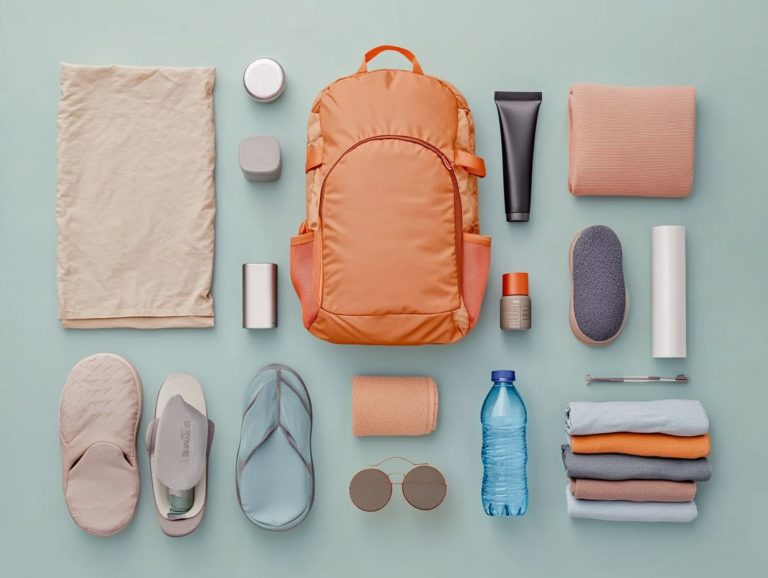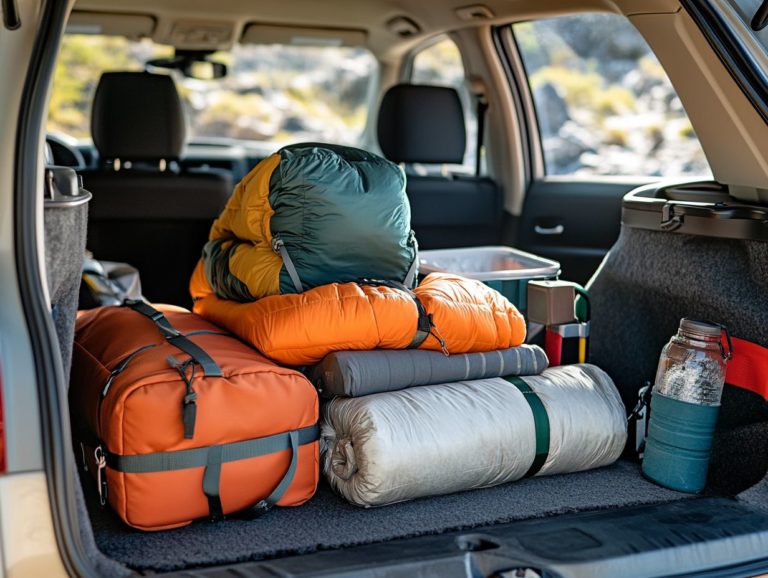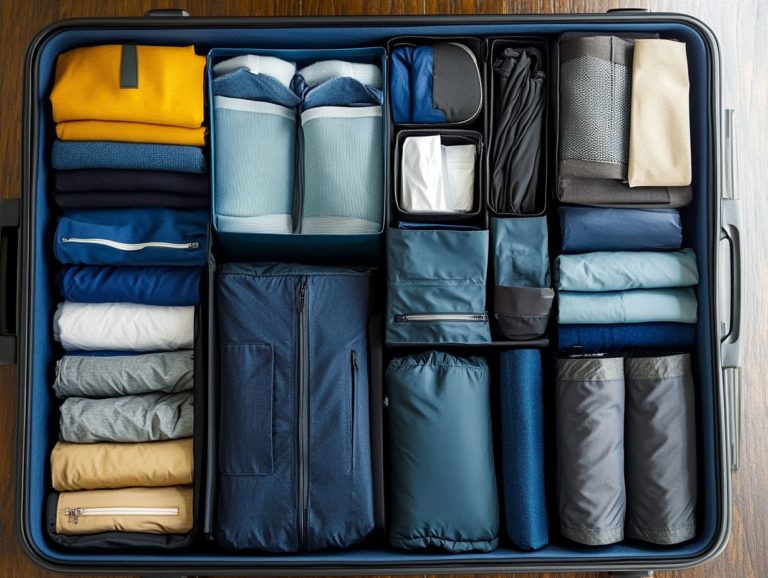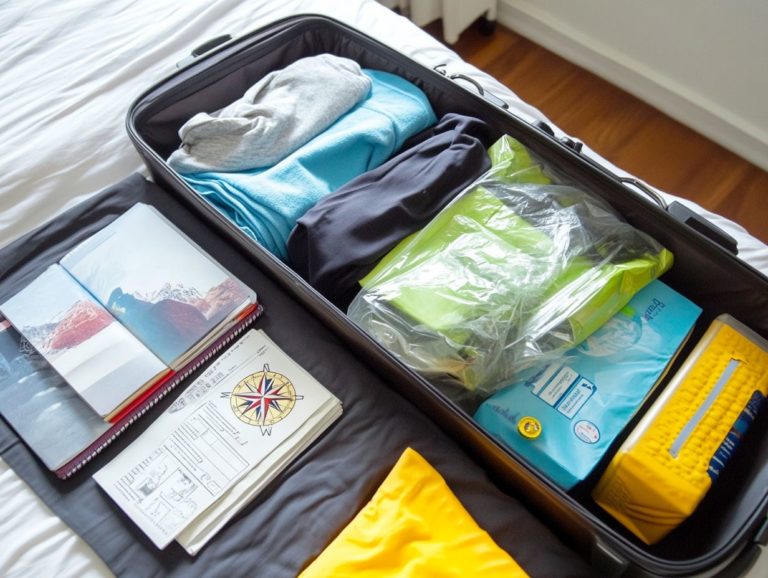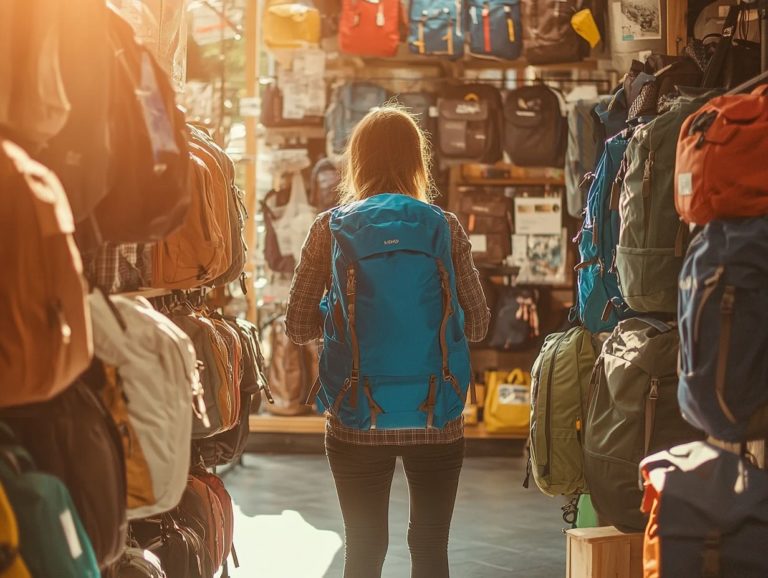Packing Light: Tips for Hiking Trips
Packing light has the power to elevate your hiking experience, turning each trek into a more enjoyable adventure. By lightening your load, every step becomes easier, allowing you to truly connect with nature and savor the journey ahead.
This article delves into the advantages of a streamlined pack, highlighting essential items to include and offering strategies for reducing weight without compromising safety or comfort.
Regardless of whether you re a seasoned hiker or a weekend warrior, these insights promise to enhance your outdoor escapades.
Contents
- Key Takeaways:
- Benefits of Packing Light for Hiking Trips
- Essential Items for a Light Hiking Pack
- Strategies for Reducing Weight in Your Pack
- Tips for Efficient Packing and Organization
- Additional Considerations for Longer Hikes
- Frequently Asked Questions
- What are some essential items to pack for a hiking trip?
- How can I save space in my backpack when packing for a hiking trip?
- What are some tips for packing food for a hiking trip?
- Should I pack any luxury items for a hiking trip?
- What should I consider when choosing a backpack for a hiking trip?
- Is there a specific way to pack my backpack for a hiking trip?
Key Takeaways:

- Packing light can make hiking trips more enjoyable and less strenuous, as it reduces the weight and strain on your body.
- Choosing multi-purpose gear and minimizing personal items can significantly decrease the weight of your pack without sacrificing functionality.
- Efficient packing and strategic choices, such as planning food and water rations and clothing options, can help lighten your pack for a more comfortable and organized hike.
Benefits of Packing Light for Hiking Trips
Packing light for your hiking trips brings a wealth of advantages, elevating your outdoor experience by easing the burden of excess gear. Whether you’re traversing the breathtaking landscapes of the Grand Canyon or conquering more challenging trails, adopting a light packing approach allows you to fully immerse yourself in nature’s wonders.
Choosing lightweight gear not only enhances your comfort while hiking but also boosts your overall travel efficiency. For more insights, consider travel light: choosing the right gear, ensuring that you prioritize essential items without sacrificing quality.
Lighter Load, Easier Hike
A lighter load means easier hikes, allowing you to navigate trails with more energy and less effort, making each step a pleasure.
Choosing hiking shoes designed for comfort elevates this experience, providing the essential support and cushioning that make long treks feel less taxing on your body. By opting for minimalistic designs, you not only lighten your load but also cultivate a deeper connection with nature.
Lightweight cooking solutions like compact stoves and dehydrated meals which are lightweight food options that require only water to prepare help you stick to a pack-light philosophy, ensuring you carry only essentials. These strategies promote effective weight management and enhance your overall enjoyment, transforming a strenuous outing into a memorable adventure filled with exploration and discovery.
Essential Items for a Light Hiking Pack
Crafting an efficient gear list is essential for putting together the perfect light hiking pack. Each item you choose should be multifunctional, ensuring that you maximize utility and carry only what you truly need. For more tips, check out the ultimate guide to packing light.
Choosing Multi-Purpose Gear
Selecting multi-purpose gear is essential for optimizing your hiking pack, as items that serve multiple functions can significantly lighten your load and elevate your outdoor experience. For example, lightweight tents that double as rain shelters provide a practical solution for unpredictable weather, ensuring you stay dry without the hassle of bulky extras.
Similarly, collapsible trekking poles that can be converted into tent supports enhance both your stability while trekking and your campsite functionality. This thoughtful gear optimization not only streamlines what you need to pack but also encourages a minimalist mindset, allowing you to focus on the essentials that simplify your journey while maintaining a manageable weight limit.
Start packing light today for a transformative hiking experience!
Minimizing Toiletries and Personal Items
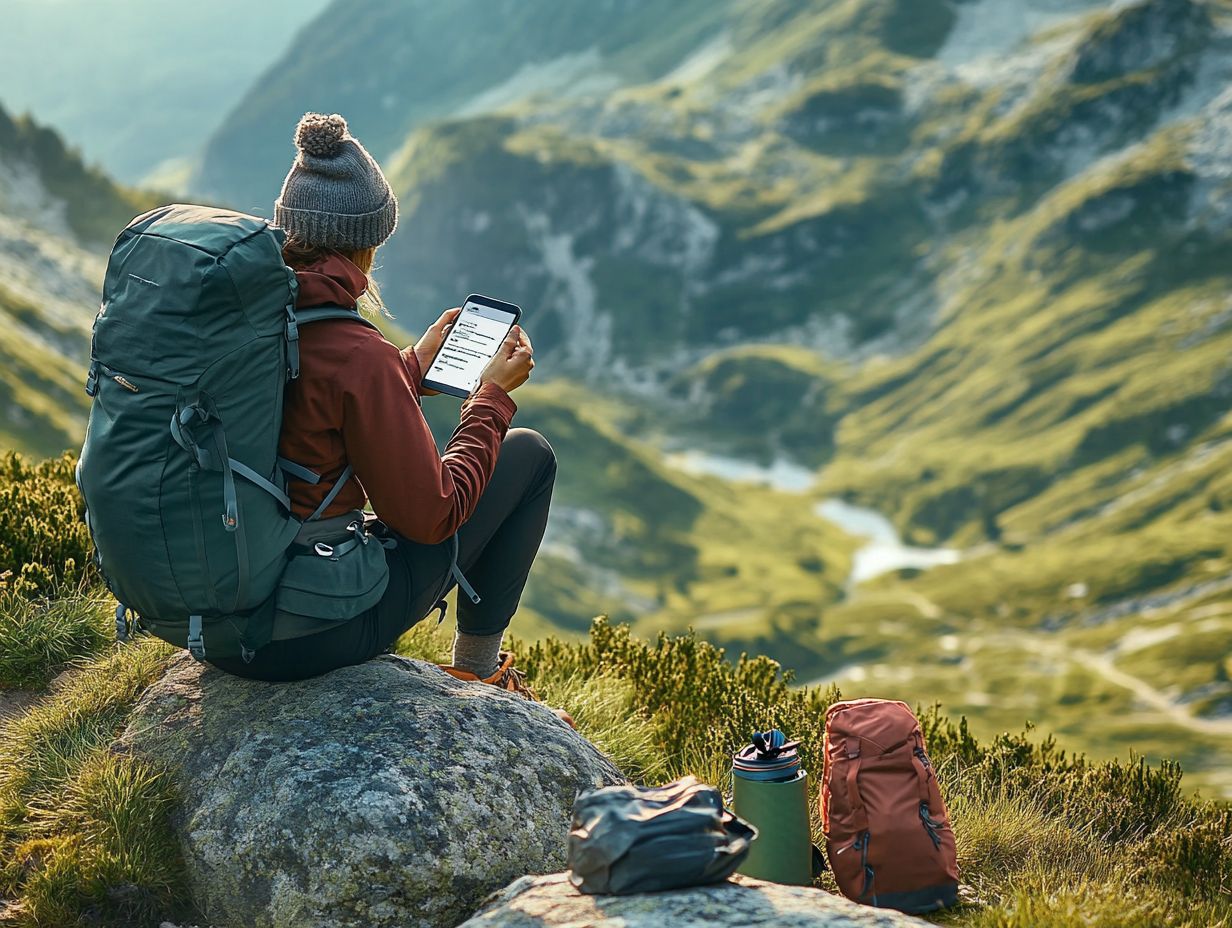
Minimizing toiletries and personal items in your pack is crucial for achieving significant weight savings. For more tips on how to lighten your load, check out traveling on a shoestring. This makes your hiking experience more enjoyable and efficient.
Focus on products that can serve more than one purpose, such as a 2-in-1 shampoo and body wash or a universal charger for your devices. This approach helps streamline your essentials.
Opt for lightweight travel-sized containers instead of full-size bottles; your back will thank you.
When it comes to emergency items, pack only the essentials you can’t do without. Consider items like a compact first-aid kit, a whistle for signaling, and a reliable multi-tool.
Using packing cubes or compression bags helps keep everything organized. It also maximizes space, ensuring your essentials are easily accessible during unexpected moments.
Strategies for Reducing Weight in Your Pack
Implementing effective strategies to reduce weight in your pack is essential for any backpacker. Doing so enhances your comfort and significantly improves your overall hiking performance.
Food and Water Considerations
When planning your hiking trip, make it a priority to choose lightweight cooking solutions and efficient hydration methods to keep your pack weight in check. Additionally, consider travel light tips for the minimalist to further streamline your gear.
Dehydrated meals are a stellar option due to their compact size and easy preparation. These meals save precious space while delivering essential nutrients without weighing you down.
Using a food scale allows you to accurately portion each meal. This ensures you bring just the right amounts, minimizing both waste and unnecessary weight.
Hydration strategies are equally important. Opting for collapsible water bottles or hydration bladders can significantly cut down on bulk. By treating water with purification tablets, you can refill your supply along the trail, helping you stay hydrated and keeping your load light.
Strategic Clothing Choices
Making strategic clothing choices is essential for a successful hiking experience. By selecting versatile clothing and lightweight footwear, you can dramatically reduce your pack weight. For additional guidance, check out these top tips for packing light in winter.
Choosing quick-drying fabrics, which dry quickly after getting wet, offers numerous benefits. This is crucial for comfort during unpredictable weather conditions.
When temperatures fluctuate, layering with thermal clothing provides essential insulation without adding unnecessary bulk. This method helps you quickly adjust to changes in weather.
By prioritizing these functional clothing options, you can enjoy the great outdoors with minimal gear. This allows you to focus more on the adventure ahead rather than the weight on your back.
Tips for Efficient Packing and Organization
Crafting an efficient packing system is essential for achieving optimal organization and accessibility. This approach enables you to pack light, ensuring your safety during your hiking adventure.
Maximizing Space and Weight Distribution

Maximizing space and ensuring proper weight distribution within your pack is vital for maintaining hiking comfort and enhancing your overall performance on the trail.
By strategically placing heavier items closer to your back and above your waistline, you can improve stability and reduce strain during long treks.
Using packing cubes not only keeps your gear organized but also allows for effective compartmentalization. This makes it easy to access essentials without disturbing your entire setup.
When evaluating your gear, distinguish between necessities and luxuries. Consider whether an item genuinely enhances your comfort or contributes to your efficiency. This can help streamline your load.
Opting for lightweight alternatives or multifunctional gear will further lighten your burden, so consider these packing tips for traveling on a shoestring, ensuring each step of your journey feels effortless and free.
Additional Considerations for Longer Hikes
When planning for longer hikes, consider additional factors like pre-trip planning and identifying resupply points. These details can greatly enhance your overall experience, ensuring that every moment on the trail is enjoyable and well-prepared.
Planning for Resupply Points
Planning for resupply points is a key strategy to enhance your travel efficiency during longer hikes. By incorporating these points, you can lighten your pack while still having access to important supplies.
Identifying these locations can transform your challenging adventure into a more manageable journey. This allows you to focus on the experience rather than the burden of your backpack.
When you review maps, seek out towns, campsites, or designated resupply stations that cater to outdoor enthusiasts like yourself. Including these spots in your packing checklist enriches your enjoyment of nature and boosts your safety. You’ll be able to replenish food and gear as needed.
By strategically planning resupply points, you can significantly reduce your pack weight. This leads to less fatigue and a more enjoyable exploration of the wilderness.
Emergency Preparedness
Emergency preparedness is crucial for hiking safety. You need to carefully consider the emergency items you include in your pack while managing weight effectively.
As you gear up for your outdoor adventures, assess the necessity of each item against its weight. Prioritize essential items like a first aid kit, a multi-tool, and a dependable light source to enhance your safety without overloading your pack.
Choose tools that serve multiple purposes to minimize weight while maximizing utility. For instance, a compact water filter can keep you hydrated, and packing lightweight emergency blankets can provide warmth without adding significant bulk.
Ultimately, striking the right balance can mean the difference between a secure outing and an uncomfortable experience when conditions take an unexpected turn.
Frequently Asked Questions
What are some essential items to pack for a hiking trip?

Some essential items to pack for a hiking trip include a lightweight tent, sleeping bag, camping stove, water filtration system, first aid kit, and proper clothing and footwear.
How can I save space in my backpack when packing for a hiking trip?
One way to save space is to use compression bags or packing cubes to condense your clothes and gear. You can also opt for multi-functional items, such as a jacket that can double as a pillow.
What are some tips for packing food for a hiking trip?
When packing food, consider weight, nutrition, and shelf life. Choose lightweight, high-energy snacks like trail mix, jerky, and energy bars. Pack meals that are easy to prepare and have a long shelf life, such as dehydrated meals or instant noodles.
Should I pack any luxury items for a hiking trip?
Keep luxury items to a minimum when hiking, as they can add unnecessary weight to your pack. However, if something brings you comfort and won’t weigh you down too much, feel free to bring it along.
What should I consider when choosing a backpack for a hiking trip?
When choosing a backpack, consider its size, weight, and comfort. Look for a backpack with a capacity of 45-65 liters, made of lightweight materials, and with padded shoulder straps and a hip belt for added support.
Is there a specific way to pack my backpack for a hiking trip?
Yes, it’s important to distribute weight in your backpack to avoid straining your back. Place heavier items at the bottom and towards the center of your pack. Use the smaller pockets for lighter items and essentials like snacks and a water bottle.
Do you have any packing tips to share? Let us know in the comments!

